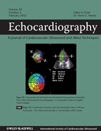Three-Dimensional Echocardiography in Congenital Heart Disease
Abstract
Complex intracardiac anatomy and spatial relationships are inherent to congenital heart defects (CHDs). Recognition of the limitations of two-dimensional echocardiography has stimulated clinical interest in three-dimensional imaging. The current review examines contemporary studies in the following areas where three-dimensional echocardiography has provided additive value in CHD: (1) visualization of morphology, (2) quantitation of chamber sizes and ventricular function, and (3) image-guided interventions. (Echocardiography 2012;29:242-247)




